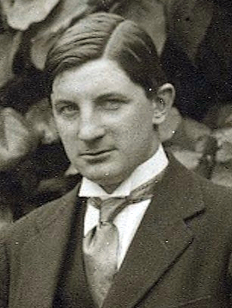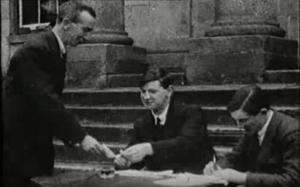Diarmuid O'Hegarty facts for kids
Quick facts for kids
Diarmuid O'Hegarty
|
|
|---|---|

O'Hegarty in 1923
|
|
| Personal details | |
| Born | December 26, 1892 Schull, County Cork, Ireland |
| Died | March 14, 1958 (aged 65) Dublin, Ireland |
| Military service | |
| Branch/service |
|
| Battles/wars | |
Diarmuid O'Hegarty (Irish: Ó hÉigeartaigh; 1892–1958) was an Irish revolutionary and a very important civil servant. He was a key member of the Irish Volunteers and the IRA. People called him the "civil servant of the revolution" because he was so good at organizing things behind the scenes.
Contents
Early Life and Education
Diarmuid O'Hegarty was born Jeremiah Stephen Hegarty on December 26, 1892, in Schull, County Cork. He was the oldest of seven children. Both his parents were teachers. His father was also involved in the Gaelic League, which promoted the Irish language and culture.
Diarmuid went to school in Cork. When he was 18, in 1910, he got a job in the Civil Service in Dublin. He worked in the Department of Agriculture and Technical Instruction.
Getting Involved in Irish Nationalism
Joining the Gaelic League
In Dublin, O'Hegarty joined the Keating Branch of the Gaelic League. This group was very active and had a strong influence from the Irish Republican Brotherhood (IRB), a secret organization working for Irish independence. Many future leaders, like Michael Collins, were members of this branch. O'Hegarty became good friends with Michael Collins here.
O'Hegarty, along with his friends Gearoid O’Sullivan and Fionan Lynch, helped teach Irish classes for the League.
Na hAisteoirí: Acting for Ireland
O'Hegarty also loved theatre. In 1913, he became a member and stage manager of a group of Gaelic actors called Na hAisteoirí. They performed plays about Irish history and culture. This helped to promote Irish nationalism and a sense of Irish identity. Many of the actors later became important revolutionaries.
The Irish Volunteers
On November 25, 1913, O'Hegarty, Gearoid O’Sullivan, and Fionan Lynch attended the meeting where the Irish Volunteers were founded. They joined that very first night. The Irish Volunteers were a group formed to protect Ireland's right to self-government. O'Hegarty became a second lieutenant in F Company, 1st Battalion.
The Easter Rising
During the Easter Rising in 1916, Diarmuid O'Hegarty was in charge of building barricades in areas like Church Street in Dublin. This area saw a lot of fighting. After the Rising, he was arrested and sent to Knutsford jail in England.
He was accidentally released early on May 18, 1916. The authorities thought he was someone else! When he returned to his job in the Civil Service, his boss, T. P. Gill, knew he had been part of the Rising. Gill told him to take his holidays and hoped he "enjoyed the time you were fighting." O'Hegarty stayed in his job until 1918, when he was fired for refusing to promise loyalty to the British Crown.
Helping Families and Rebuilding the Volunteers
After the Easter Rising, many Irish revolutionaries were killed or put in prison. Two groups were formed to help their families: the Irish Volunteers Dependent's Fund (IVDF) and the Irish National Aid Association (INAA).
O'Hegarty was a key member of the IVDF. When the two groups joined together in September 1916, O'Hegarty helped make sure the new organization, the INA&VDF, was led by people who wanted a fully independent Ireland. This group not only helped families but also became a way to restart the movement for independence.
Reorganizing the Irish Volunteers
After his release from prison, O'Hegarty played a big part in reorganizing the Irish Volunteers. He traveled around Ireland with Seán Ó Muirthile, connecting with leaders who hadn't been arrested. They helped get the Volunteers back together, especially those who were being released from prison.
In October 1916, O'Hegarty helped organize the first big meeting of the Volunteers. An executive committee was set up to continue reorganizing the group. This committee included O'Hegarty and was mostly made up of members of the IRB.
Working for the New Irish Government
The First Dáil Éireann
In 1918, Sinn Féin, a political party that wanted Irish independence, won most of the seats in the general election. In January 1919, these elected Sinn Féin members formed their own independent parliament called Dáil Éireann.
O'Hegarty was very close to Michael Collins and Harry Boland. He used his amazing organizing skills to help choose the Sinn Féin candidates for the 1918 election. He didn't want to be elected himself, preferring to work behind the scenes.
Raising Money for the Dáil
In 1919, Michael Collins, who was the Minister for Finance, started raising money for the Dáil. This money was needed to run the new Irish government and support the Irish Volunteers.
A short film was made to encourage people to buy "Dáil Bonds." It showed Michael Collins and Diarmuid O'Hegarty signing bond certificates. This film was a powerful way to show people that the Dáil was a real government.
Secretary to the Dáil
O'Hegarty was the main organizer as the secretary to the First Dáil from 1919 to 1921. He made sure the Dáil worked like a proper government. He organized secret meetings of the parliament and helped coordinate the work of different government departments.
He kept all the records and handled all the letters for the Dáil cabinet. Because he was the link between all the ministers, he was central to how the government operated while it was on the run from the British. His important roles in the IRB and the military also gave him a lot of influence.
In November 1919, the British arrested him. He was jailed for three months in Mountjoy Prison for holding an illegal meeting. While in prison, he became a leader among the IRA prisoners.
The War of Independence
During the War of Irish Independence, O'Hegarty continued to hold important military roles. He was a member of the Irish Volunteer executive and the IRA's Director of Communications.
Director of Organisation
In March 1920, after being released from prison, O'Hegarty took over from Michael Collins as the Director of Organisation for the IRA. This meant he was in charge of organizing the different units of the army. He also became vice-commandant of the Dublin brigade. This allowed Collins to focus on intelligence work.
O'Hegarty was a close friend of both Michael Collins and Harry Boland. Collins described O'Hegarty as someone who worked very hard, had a quick and clever mind, and often disguised his sharp intellect with a casual manner.
On November 21, 1920, O'Hegarty helped the IRA's "Squad" in Dublin. This day became known as Bloody Sunday.
Tom Barry, another important IRA leader, described O'Hegarty as a "brilliant organiser with a first-class brain." He noted that O'Hegarty didn't speak much but was highly respected by other leaders.
The Anglo-Irish Treaty
In April 1921, O'Hegarty stopped his military duties to focus on his work with the Dáil. In October 1921, he was part of the Irish team that went to London to negotiate the Anglo-Irish Treaty with the British government. He served as a joint secretary for the Irish delegation.
The delegation included famous figures like Arthur Griffith and Michael Collins. O'Hegarty's skills were highly praised during these important talks.
The Irish Civil War
On January 7, 1922, the Dáil voted to accept the Anglo-Irish Treaty. This decision caused a split in the Irish independence movement, leading to the Irish Civil War.
O'Hegarty strongly supported the Treaty. He became secretary to the cabinet of the new Provisional Government in 1922. He even took part in talks to try and unite the army and prevent the Civil War, but these talks were not successful.
When the new Irish Free State took over the British Army headquarters in Ireland, O'Hegarty was one of five key people present on behalf of Ireland.
Governor of Mountjoy Jail
During the Civil War, in July 1922, there was a big riot by republican prisoners in Mountjoy Prison. Diarmuid O'Hegarty was temporarily assigned to be the military Governor of Mountjoy Prison.
Conditions in the prison were very tough, and prisoners often tried to resist. O'Hegarty demanded that the prisoners stop their protests. He warned that they would be treated as "military captives" and could be shot if they resisted. When prisoners refused to stop leaning out of windows and shouting to crowds outside, soldiers opened fire on the windows. Luckily, no one died, but some prisoners were wounded.
Later Military Roles
O'Hegarty was a General Staff Officer during the Civil War, holding the rank of Commandant General. He was also a member of the Army Council from September 1922. He served a second time as Director of Organization for the army.
After Michael Collins died in September 1922, O'Hegarty was appointed Director of Intelligence for the National Army until May 1923. He worked to expand the intelligence network beyond Dublin.
Later Life and Public Service
In March 1923, O'Hegarty left the army to return to his full-time civil service career. He became the Secretary to the Executive Council of the Irish Free State, which was like being the chief administrator for the government. He held this important position from 1922 to 1932. He was also the main private secretary to the president, W. T. Cosgrave.
He was known for his excellent work at international conferences in 1926 and 1930. In 1932, when a new government came to power under Éamon de Valera, O'Hegarty was one of the few senior civil servants who was removed from his position.
Commissioner of Public Works
From 1932, O'Hegarty became a Commissioner of Public Works. This meant he was responsible for government buildings, mostly in Dublin. In 1949, he was made Chairman of the Commission, a position he held until he retired in 1957. He also served on committees advising on wartime spending and transportation issues.
Family Life
On April 27, 1922, Diarmuid O'Hegarty married Claire Archer. Michael Collins was his best man at the wedding. They had two sons and two daughters.
Diarmuid O'Hegarty passed away on March 14, 1958, in Dublin. He was buried in Deans Grange. He was a keen golfer and a member of Milltown Golf Club.
Images for kids




